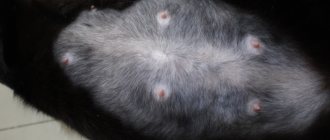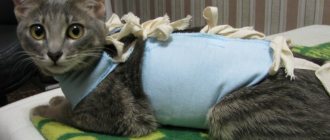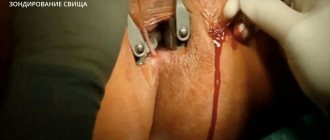The first days after sterilization and cat behavior
Immediately after the operation, cats are usually under the influence of anesthesia and do not recover from this state immediately.
Often, a pet’s return to its previous lifestyle can take several days. And at this time, the animal, being under stress, may begin to behave in unusual ways. Sometimes this may be a sign of some pathological process in the body, and then timely veterinary assistance cannot be avoided.
But how should owners behave in the first couple of days after sterilizing their pet and what should they do? This will be discussed below.
First day
If a cat sleeps a lot on the first day after sterilization, this should not be surprising or, even less, frightening: such behavior during the postoperative period is quite normal and understandable.
After all, the animal is still under the influence of anesthesia, from which it will recover within several hours, or even a whole day.
Attention!
When the cat begins to raise its head and roll over, it can be considered that it has come out of anesthesia. However, this does not mean that no more problems can be expected: on the contrary, in order to prevent postoperative complications, it is necessary to carefully monitor the pet.
Refusal to eat and drink on the first day after surgery is also considered normal. The cat simply feels sick after anesthesia, in addition, she begins to experience pain and discomfort, and in such a situation it is quite natural that she does not want to eat or drink.
However, in addition to these behavioral features in the postoperative period, other abnormalities may be observed in your furry pet.
Most often, this turns out to be due to the fact that the animal is still under the influence of intoxicating substances.
In this state, the cat may even experience hallucinations in which he either tries to run away or jump out of the window, or his level of aggression increases.
Also, the purr may begin to make loud screams, walk around the apartment with a stilted gait without any purpose, and every now and then bumping into furniture. This behavior is considered acceptable after the operation, but only if no more than 12 hours have passed since its completion.
What should the owner do in this case? There is only one thing: if possible, isolate the pet for a while in a carrier or in a cage, and, if this is not possible, then monitor it very carefully, preventing possible accidents.
Important!
All windows and vents should be closed on the first day after sterilization, and the cat should not be allowed to jump on top, as there is a very high risk that it will fall from there and injure itself.
Second day
On the second day after sterilization, the cat begins to return to normal.
At this time, it is considered a very good sign that she is interested in food.
But even if the pet does not eat anything, but still drinks plenty, this can also be considered a variant of the norm.
Attention!
Don’t be alarmed if your cat has a single attack of vomiting on the second day or has a slight upset of the digestive system.
At this time, you should protect your pet from stressful situations and, of course, make sure that she does not lick the seam. In order to completely protect your pet from infection in the wound or its dehiscence, it is recommended to put a special blanket on the animal, and a post-operative collar in the form of a cone on the neck, which will not allow her to reach the seam on her stomach with her tongue.
What should you pay attention to and when should you worry?
However, there are signs of cat behavior during the postoperative period that should alert the owner and prompt him to seek veterinary help:
- On the first day after the operation, Murka is completely indifferent to water.
- The cat looks excessively lethargic and apathetic, sometimes even, as they say, lies flat.
- The animal breathes unnaturally: with wheezing and excessively quickly, or, conversely, very slowly.
- The seam becomes wet and ichor leaks from it.
- The pet emits a very unpleasant, perhaps even putrid odor: this often indicates a developing inflammatory process.
Important!
By the fifth day after sterilization, the cat is almost back to normal. She eats with appetite and drinks willingly, and her behavior becomes close to its previous pre-operative behavior. If your pet still shows lethargy and apathy, and also refuses to eat and drink, then you must immediately take it to a veterinary clinic.
What else do you need to know
For a while, the cat litter should be replaced with paper . The fact is that particles of filler that get into the cut can cause infection. Also, after the operation, it is necessary to ensure that the suture does not bleed and is clean. If there is discharge, contact your veterinarian immediately as the wound may become infected. After sterilization, a cat requires special treatment. Pressing on the stitches may cause pain.
Sterilization for an animal is accompanied by great stress. In addition, the immune system weakens and the cat can be susceptible to various diseases, so you need to monitor its general condition: how much it eats, how it drinks, how it goes to the toilet.
two weeks for the cat to fully recover . When estrogen stops entering the body, pets begin to eat a lot. Metabolism slows down and the animal may gain weight. To prevent a cat from becoming obese, it is necessary that it moves more, you need to walk and play with it, and also provide food for its diet.
How can a cat change?
Many people believe that after sterilization, their furry pet will become completely different, and its behavior will change radically. But do these assumptions have any real basis, or are they nothing more than speculation? Let's try to figure this out.
Will she catch mice?
For city residents, this issue is less relevant than for owners living in a private house.
Many of them do not dare to sterilize their cat only out of fear that she will suddenly stop catching mice and other harmful rodents. But is this really so?
Let’s say right away that sterilization does not in any way affect a cat’s ability to catch mice or its hunting instincts. She either already has them from birth, or she doesn’t and never will.
Important!
Many of the owners of mousetrap cats noticed that after sterilization, their pet began to bring more rodents than before. This is most likely due to the fact that after suppressing the reproductive instinct, the cat is no longer distracted by cats and caring for offspring, but is engaged in its calling - hunting rodents.
Will he stop marking and shitting?
Many of the owners of furry beauties sterilize their pet only because they hope in this way to rid her of the habit of crap everywhere and mark furniture and corners. But often their expectations are not always met and in order to wean a cat from these bad habits, one operation is not enough. Why is this happening?
- During the operation, the ovaries were not completely removed, and the remaining particles continue to produce sex hormones. In this case, it is recommended to perform a second operation.
- Sterilization was carried out at puberty. In this case, the reproductive instinct and parental behavior have already become entrenched, which does not allow achieving a lasting effect after sterilization.
- The animal is stressed or in pain. In this way, it is simply trying to attract attention to itself and let its owners understand that not everything is fine with it and it needs help. In this case, a gentle and caring attitude towards your pet can help, and, in some cases, going to the clinic.
Important!
Whatever the reason that the cat continues to crap and mark in the house, despite seemingly successful sterilization, its destructive behavior is nothing more than a desire, even in this way, to attract attention to itself.
Reverse effect: why can cats stop going to the litter box after sterilization?
Sometimes after sterilization, the cat does not go to the tray, which it has long been accustomed to. But why does this happen?
There can be many reasons for this behavior:
- Stress. It is he who, most often, is the reason why a pet can “forget” that it needs to do its business in the tray. Does a cat experience stress after sterilization? Yes, definitely. There is pain, discomfort due to tightening stitches, and unpleasant memories of a trip to the clinic that ended with an operation.
- The tray is too clean. Many owners, after surgery, in order to exclude the possibility of infection in the wound, wash the tray too thoroughly and wash off the animal’s usual odors from it.
- Unsuitable filler. He can simply prick her even through the blanket at the seam, which can cause a sharp hostility towards the tray.
How to fix this?
- When stressed, you need to give your pet as much attention as possible. You should also save her from any stressful situation, since for a cat the operation itself and the subsequent healing of the wound are already too much of a shock.
- If the tray is washed too thoroughly, perhaps even with the use of chemical detergents, then you just need to not be too zealous about it. And it’s better to avoid detergent altogether, especially since it can cause allergies in the animal or simply irritate the skin.
- Unsuitable litter should be replaced with something more comfortable for the cat. Moreover, it is better not to use another filler, but to use pieces of newspaper or any other non-waxed paper. And the best option is to give it up altogether for a while, allowing the cat to simply go into an empty tray and washing it after each use.
General care characteristics
After sterilization, cats look dirty. There may be blood on the fur. But bathing the animal for the first ten days is strictly prohibited . Avoid contact with water.
It is also very important to follow the following rules:
- do not give the animal any antibiotics;
- as a filler for the tray, use special store-bought sand, or even better, cut paper;
- change the filler and thoroughly “wash” the tray after each stool.
- Another important point that is very scary. After sterilization, animals often sleep with their eyes open. This is considered normal. To prevent drying out, you need to instill eye drops with a special solution. It is also recommended to close and open the animal’s eyelids every half hour while sleeping.
Caring for a cat after home sterilization requires not only patience, but also love.
Frightened and suffering from pain and hormonal changes, the animal needs affection. The owner’s emotional mood will help him survive this difficult period.
How does character change?
There is also an opinion that after sterilization, a cat’s character may change, they say, after the operation she will become calmer and more affectionate, and aggression, if there was one before, will disappear without a trace. To some extent, these statements are true, but this is not always the case.
Important!
Earlier sterilization can really change the character of a cat, but after an operation performed in adulthood, this sometimes does not happen.
Showing increased affection
After sterilization, many pets become more affectionate and peaceful: they are calmer towards their relatives and become more contactable when communicating with their owners, for example, they try to be in their presence more.
However, sterilization does not have the same effect on some furry individuals: a cat that is too independent or aggressive is unlikely to become much more affectionate and affectionate towards people, and if its aggression can be muted, it will only be slightly.
Important!
As a rule, those Murkas whose sterilization was delayed for several years do not become more friendly after the operation. During this time, they have already developed a character, which is not always possible to change.
Much calmer?
Many owners of furry beauties note that their cat has become calmer after surgery. And, indeed, her mood swings, as a rule, disappear and she no longer exhibits inappropriate behavior during estrus: in particular, the purr no longer calls her partners with shrill screams and does not mark in the house.
In addition, she practically stops paying attention to other cats and other people’s kittens. And, if there are several cats in the house, the operated animal does not start fights with its neighbors, but, on the contrary, treats them almost like family members: it constantly licks their fur, purring at the same time.
Manifestation of aggression and what to do about it?
Sometimes it happens that after sterilization, a previously affectionate and calm pet suddenly begins to show aggression. This behavior may also be due to the fact that after the operation, sex hormones, which also affect the behavior of the animal, simply cease to be produced.
However, much more often the causes of aggression are not related to changes in hormonal levels in the body, but depend on completely different circumstances, such as:
- Stress
- Pain or discomfort.
- External stimuli that create an additional stressful situation.
Important!
Most often, aggression is a defensive reaction to pain. The cat experiences unpleasant sensations, but does not understand the reason for them and therefore attacks everyone who tries to approach it or, especially, pick it up.
What should the owner do with all this?
- Eliminate additional stressful situations and provide your pet with the greatest comfort and a calm environment in the home.
- Leave the pet alone for a while: do not bother her, and, especially, do not try to touch or pick her up.
- It may be worthwhile to consult a veterinarian about pain medication if the pain is severe.
Depression and what to do about it?
It’s not common, but it happens that sterilization does not have the best effect on a cat’s behavior: she sometimes even becomes depressed. This often leads to the most serious consequences. The animal may begin to refuse food, hide, and, in particularly difficult cases, even run away from home, often ending its life on the street.
How to avoid this? First of all, it is necessary, as in cases of stress, to devote as much time as possible to your pet so that she does not feel abandoned and unnecessary.
Important!
Sometimes this state of despondency can last for the first few months after the operation, and all this time the owner needs to be especially attentive, caring and affectionate towards his pet.
How to help your pet?
There are a number of recommendations from veterinarians for the process of cat rehabilitation at home:
- you need to put the pet on the floor, since due to impaired coordination of movements after anesthesia, it may fall from a hill;
- the cat should not lie near heating appliances - this can cause internal bleeding;
- It is worth laying down an absorbent diaper, as the cat may spontaneously urinate, defecate or vomit;
- you need to put the pet on its right side to reduce the load on the heart;
- if a cat has a weakened immune system, it needs a course of vitamins and restoratives;
- in the first hours after surgery, it is necessary to measure the cat’s temperature once an hour and carefully turn it over every half hour to avoid numbness in its paws;
- if ulcers, crusts, rashes or redness form in the suture area, consult a veterinarian;
- in case of sudden vomiting, it is necessary to turn the cat’s head to the side and make sure that it does not choke;
- to prevent licking and scratching of the stitches, as well as to protect the wound from dust and dirt, you need to put a postoperative blanket on your pet;
- stitches must be treated in accordance with the recommendations of the veterinarian.
Important!
If symptoms such as bleeding from the suture, the cat's heavy breathing, wheezing in the chest, uneven heartbeat, pale or red mucous membranes, or a rash occur, you should immediately take the animal to the veterinarian.
If all recommendations are followed, the cat will recover from anesthesia easier and recover faster.
What to pay attention to in a month?
After a month has passed since sterilization, the cat becomes more active. She may also become more affectionate and calm, and at the same time require increased attention to herself. As a matter of fact, a month after the operation, nothing should remind you of its completion except for a purring area of bare skin on the abdomen.
Important!
If your cat continues to be lethargic or shows other signs of destructive behavior, it is best to take her to the veterinarian as soon as possible.
Host reviews
Ekaterina, 31 years old, Novosibirsk
I found Fenya in the winter as a tiny kitten that someone dropped at our entrance. Because of the cold, it seems she couldn’t even meow, she was so frozen, poor thing... Naturally, I couldn’t pass by this half-dead lump, I took her, warmed her up and left her with me.
When I picked her up from the street, I didn’t even know that she was a female kitten; this became clear later, during an examination at the clinic. Then the doctors asked me if I would later sterilize Fenya, I answered no. But when I returned home, I started thinking about what would happen next. Fenya is a cat, which means that sooner or later she will have kittens that will need to be adopted. And it’s not that there would be many problems with the device, it’s just... I didn’t want one of my cat’s children or grandchildren to end up on the street, just like she once did, where they might have been hit by a car or torn apart by dogs.
The decision to sterilize was not easy, but the reluctance to endanger the lives of Feni’s future kittens overcame all fears. And so, when my cat was eight months old, I took her for surgery, which she endured surprisingly easily. True, some surprises awaited me at home, starting with the fact that Fenechka slept for a very long time on the first day - at least half a day after sterilization, and when she came to, she lost orientation in space for some time: she kept bumping into something on the walls, then on the furniture in the room. I was even afraid that she had gone blind due to the anesthesia. However, after a while everything got better and, apart from the fact that the cat was still quite lethargic and apathetic, she at least no longer looked stunned as she did on the first day after the operation.
Nowadays, six months after sterilization, I can say that Fenin’s character has hardly changed: she was still a sweetheart. Well, maybe she became a little more calm and imposing. But this may not be at all related to sterilization, the cat has simply matured - that’s all.
Victoria, 24 years old, Tomsk
We didn't originally plan to have our Brittany spayed. The cat was taken for exhibitions and breeding, but, as it turned out, everything is not so simple. While the kitten was small, everything was fine, but then Bree began to mark her territory. I would never have thought that cats, especially purebred ones, could do this! I no longer wanted any kittens, but only wanted one thing: for the cat to stop dirtying the apartment. At the family council, the issue of sterilization was adopted, and, having agreed on the operation at the clinic, my husband and I took our failed breeder cat there.
Of course, we had fears that something might go wrong. But the doctor calmed us down, told us not to worry, and that, most importantly, we were on time with the operation: a few more months and it would have been impossible to wean Bree from leaving marks even after sterilization.
What can I say about our main problem? It really resolved itself in the best possible way, however, in addition to the operation, I also had to additionally raise a cat. Nevertheless, we are pleased with the result and are sure that without sterilization, Brittany would have continued to cause mischief in the apartment.
Yaroslav, 42 years old, Stavropol region
Muska of a simple noble breed was given to us by our relatives as soon as we moved into the house, they say, when we move, we need to introduce the cat first, so that there will be happiness in the house. We appreciated their gift only later, when it turned out that our underground was full of mice. Fortunately, Muska, despite her very young age, coped well with them, and at least they didn’t snoop around our kitchen and rooms. And for the time being everything was fine, until our cat unexpectedly went on a spree. We still don’t know where she gave birth to kittens and hid them for the first weeks. She brought her offspring to us when they were already grown up, so we had to add her brood almost immediately after that. How we accommodated them in the village is a separate conversation, but after this incident it was decided to sterilize Muska so that this epic with cat children would not happen again. But we were afraid that after the operation the cat would become lazy and not want to catch mice. But, fortunately, it turned out that this was not the case. As a result, despite the fact that after sterilization Muska is still an excellent catcher of mice, it even seems that she has begun to catch more of them than before.
How long does it take for an animal to move away?
The cat sterilization operation is performed in a veterinary clinic and lasts approximately 40 minutes. The length of time the animal recovers from anesthesia depends on which of the three types was used:
- Muscle relaxants + analgesics. This mixture is used most often as it is the most effective. A significant disadvantage of such anesthesia is the difficult and rather long recovery from it, which lasts from 5-6 to 24 hours.
- Muscle relaxants along with epidural anesthesia. When using this type of anesthesia, the experience and qualifications of the doctor play an important role, since if the injection into the epidural space is performed incorrectly, there is a risk that the sensitivity of the hind limbs and the ability to move them will return within 48 hours. The advantage of this mixture is its low toxicity, due to which anesthesia is easily tolerated and recovery from it takes a maximum of 8 hours.
- Gas or inhalation anesthesia. This method is highly effective and minimally toxic, but it is used infrequently due to the lack of necessary equipment and substances. After such anesthesia, the animal comes to its senses almost immediately after the anesthesia machine is turned off.
Conclusion
Sterilization can indeed affect the character and behavior of a cat, but this does not always happen. Most purrs, even when sterilized, retain their previous character and behavioral characteristics, except for the fact that they no longer show interest in breeding. In those cases when changes in the character of a furry pet do occur, most often this turns out to be due to early sterilization, when the cat’s character has not yet had time to be fully formed.










